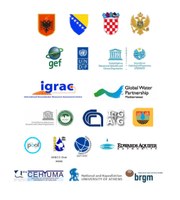Project Management Structure
(i) Execution of Project Activities
From the point of view of the fulfilling all contractual obligations, and adherence to GEF, UNDP and UNESCO administrative procedures and general principles, the Project Coordination Unit (PCU) work in coordination with UNESCO IHP and under the guidance of the Project Steering Committee (SC).
The Project Steering Committee (SC) is composed of one senior government official from each country, designated by the Countries’ GEF Operational Focal Point (OFP), the UNDP-GEF Regional Technical Advisor for Europe/CIS (or their designated representatives) and UNESCO IHP senior expert responsible for the groundwater and ISARM activities at the IHP Secretariat (or their designated representative). NEU (National Execution Unit) members and other stakeholders may be invited to sit on the Committee as observers upon request of the full members. The Project CTA acts as secretary of the SC.
The Project Management Team is composed of:
- UNESCO IHP that supervises the project execution,
- The Project Coordination Unit (PCU), headed by a Chief Technical Advisor (CTA),
- The National Focal Points -head of the National Execution Units (NEU).
The PCU together with UNESCO IHP coordinates the project supported by the NEUs. The NEUs consist of the national DIKTAS Focal Point and local experts hired by the project. The PCU is also supported by regional and international experts hired by the project and the Stakeholder, Public Participation and Communication Facility, operated by GWP-Med.
The PCU carries out the day-to-day implementation of the Project and is responsible to UNESCO IHP and UNDP RTA for the project activities, financial accountability, staff welfare and discipline, etc, as well as a number of management and evaluation activities.
The Chief Technical Advisor (CTA) as head of the PCU is appointed by UNDP and UNESCO in consultation with the countries.
Project Management structure (click to enlarge)
(ii) Sustainable Management of the DIKTAS – Since its early stages, the project continually strives to bring about improvements in the management of karst groundwater both at the national and at the regional levels, and to facilitate the establishment and operation of management and consultation structures that play a fundamental role during project execution, and in time will represent the core of future integrated management at both levels. Each country is establishing, for the purpose of the project and of karst groundwater management, a National Inter-ministerial Committee (NIC) composed of high level representatives of all ministries and agencies involved in water resources and land use planning. The Committee plays a key role in the preparation of the TDA and SAP, and will be the body that will approve national NIPs, and dialogue with the Regional Consultation and Information Exchange (CIE) body. The later is created as part of the project and will represent the centre of international cooperation for the DIKTAS within the project’s context, and beyond. The linkages between the NICs and the CIE are shown in figure below.
One of the first acts of UNESCO in the project was to establish a Science Advisory Panel, comprising a selected group of eminent scientists from the region and outside the region, including scientists from GEF recipient countries not participating to the project as yet (Serbia) and from Slovenia, Italy and Greece (and other Karst countries and inviting contribution from UNESCO Chairs on Karst and UNESCO Category 2 centres from other regions). This Panel holds meetings upon request of the PCU, e.g.: for the review of the TDA draft, to support CIE activities, for review of the draft SAP, etc. This exchange of best practices and scientific knowledge at regional and international level trough the UNESCO IHP network sets the base for the project results long term sustainability.



